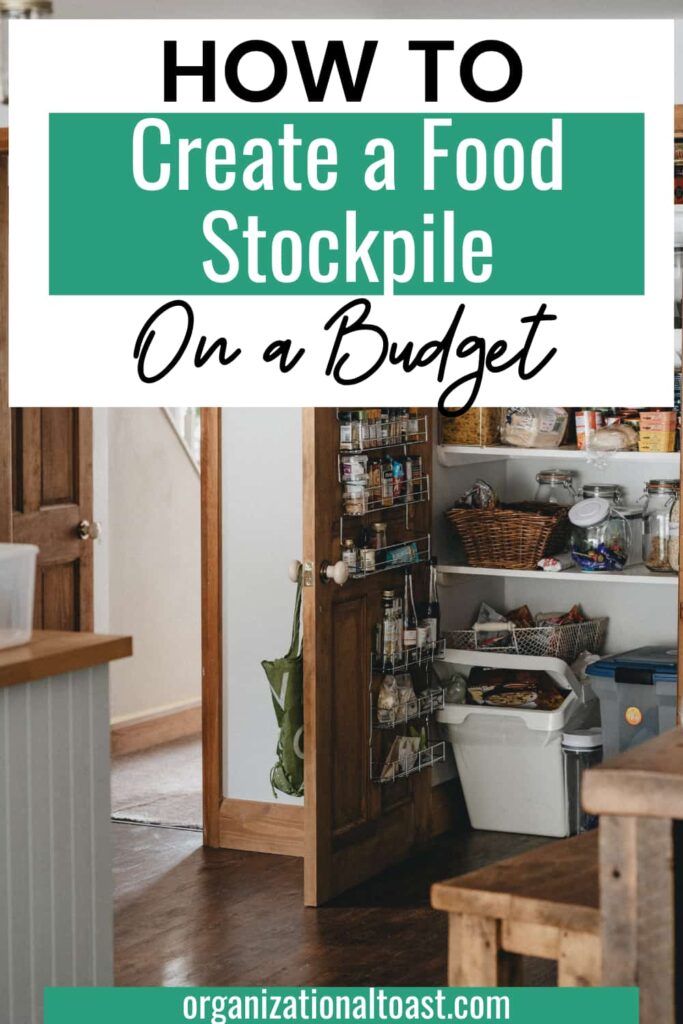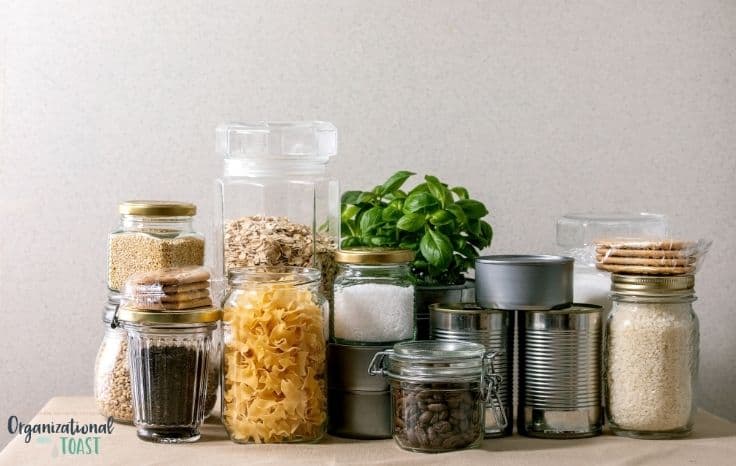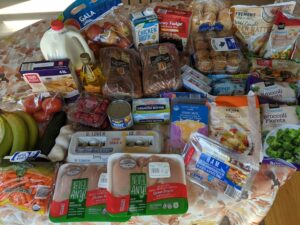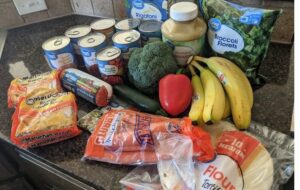Sharing is caring!
Many of us know having a food stockpile can help us in an emergency, but we also have a hard time getting started and figuring out what to stockpile without creating waste!
Here you’ll find some practical tips on how to stock your pantry without breaking the bank or cluttering your house with cans.
What is a food stockpile?
A food stockpile is an emergency stash of food, typically non-perishable foods with a long shelf life you have on hand in case of an emergency. The foods in your stockpile are items you don’t pull from daily to cook and feed your family. Instead, these are items that are kept on hand for the purpose of eating when your “regular” groceries run out.
A food stockpile doesn’t have to be limited to your pantry. You can also stockpile meats and other frozen foods in your freezer. This could mean having an extra freezer for stocking up or creating space in your current freezer for a small stockpile.
Why should you stock your pantry?
Creating a pantry stockpile is like buying insurance. You’re investing in a safety net for unforeseen circumstances for you and your family. The reasons for creating a stockpile might include:
- Job loss
- Natural Disaster (think blizzards, hurricanes etc)
- Illness
- Financial Hardships
Before you begin stockpiling, consider why you are creating a stockpile? If it’s to prepare for hurricane season, your stockpile will look different from if you’re preparing for financial hardship.
Knowing why you want a stockpile will also help you come up with a plan and a budget. If it’s planning for natural disasters, you’ll want to follow local and national guidelines for how much food and water to prepare and for what amount of time.
If it’s for job loss or financial hardship, this may be trickier to plan for. Begin with a goal of 2 weeks worth of food and then build up from there.
Knowing your why will ensure you only buy what you need and you don’t end up throwing out or wasting food.
Now that you know why you are creating a pantry stockpile, follow these 7 easy steps to get started!
1. Take an inventory
Figure out what you already have on hand. Create a written inventory is a great way to help plan out your stockpile.
Plus, writing an inventory often helps us realize just how much food we already have on hand! This is also a great time to clean out the pantry and freezer of any items pass their use by date.
2. How Much Space Do You Have?
Where do you plan on keeping your stockpile? Will your pantry fit a stockpile or do you need to consider other storage options?
Knowing how much space you have and planning out your space is key! You don’t want to end up stacking cans all over the place and creating clutter and mess.
Even if you live in a small space, there are lots of creative stockpile storage options. You can expand your existing pantry space with a pantry organizer or you can store your stockpile in a coat closet or in plastic containers under the bed. You may even be able to merge some kitchen cabinet space to make room for a stockpile.
3. What Should You Buy?
Make a list of the foods you know you and your family will eat. Pick foods with a long shelf life that can be easily stored. You may even look into some recipes that use only pantry items.
This master list will serve as a guide to help you when it comes time to shop. You can also cross off items from the list once you have an appropriate amount.
Here are some basic pantry and freezer food staples to help you get started:
- Pasta
- Rice
- Beans
- Canned Vegetables
- Canned Fruits
- Canned meats (chicken, tuna, salmon etc)
- Canned or boxed milk
- Coffee
- Oatmeal
- Nuts (roasted nuts, peanut butter,
- Baking Supplies (flour, sugar, baking soda etc)
- Bread (homemade or store bought freezes well)
- Oil, Vinegar
- Stock/Broth (chicken, vegetable, beef)
- Dairy and Eggs
- Meat and Seafood
4. Take your time
Now that you are armed with a plan don’t rush out and start buying everything. It can be exciting to have a plan in place knowing that you are creating this safety net for your family. But don’t start buying everything up.
Take a breath and walk away.
Take a week off and then review your inventory and master list. Does it make sense? Are there food items you left off the list of things you need? Are there items on there you don’t really want?
5. Create a budget
Now that you’ve made a plan and taken a step back it’s time to create your stockpiling budget.
Based on your stockpile goals and your existing grocery budget, allocate a small amount of your existing grocery budget for your stockpile. This might mean blocking off $5-20 a week for your stockpile items. I recommend using your existing grocery budget to create a stockpile and not adding to your grocery budget.
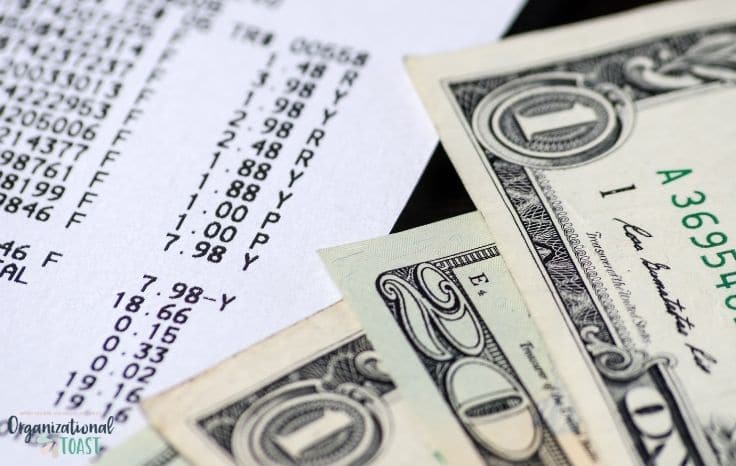
6. Know Prices
You can make that small part of your grocery budget go a long way if you watch out for sales and know your prices. Buy one get one deals and similar sales are a great way to save but only if you really can save! If you’re stocking up on buy one get one deals, but you can buy the items for less at another store you may not end up saving all that much.
That’s where knowing prices can go a long way!
Also, using an app like Ibotta can help you earn money back on your purchases. You can even use that earned money to help build up your stockpile!
7. Stay Organized
You don’t have to go crazy labeling every last thing, but you’ll want to create some system for keeping your stockpile organized. This could be as simple as keeping all similar items stacked together. You can even organize by use date, bringing those items that need to be used first forward.
Maintaining a stockpile is not a one time event. As your stockpile begins to grow, you’ll want to go through it every 6 months to make sure nothing is about to expire.
If an item is close to its use by date, use it! Since you have a portion of your grocery budget allocated for your stockpile you can easily replace it on your next trip to the grocery store.
Creating a food stockpile is a great way to build a safety net for your family and it can be done on any budget with the right amount of planning.
Looking for more grocery money saving tips? Check out:
- How To Do An Eat Down the Pantry Challenge
- Cheap Meals Your Family Will Love
- Meal Planning for Beginners + Free Meal Planning Template
